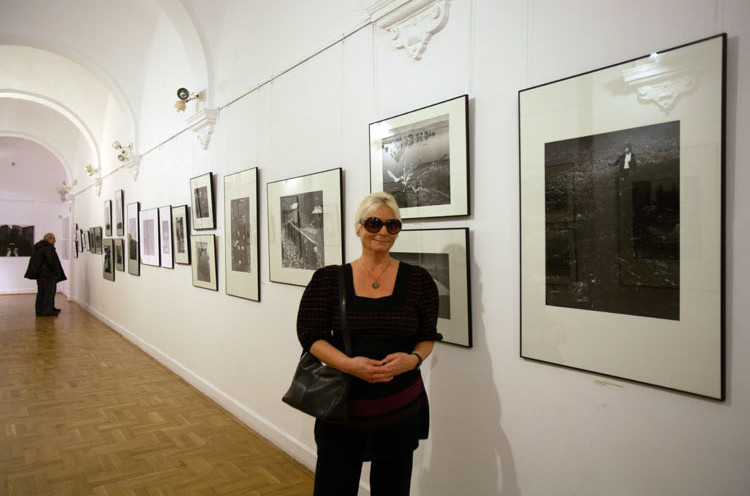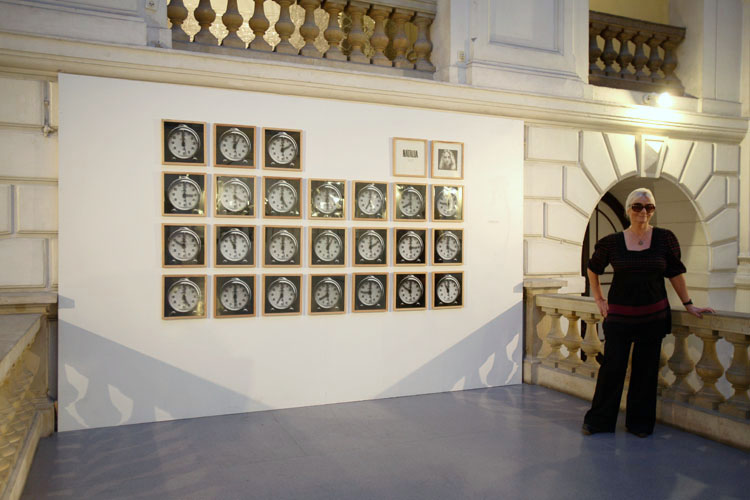
In the nature, 1964

Permanent measurement – 24 hours, 1970
photographs: Mateusz Madelski
„24 HOURS – PERMANENT REGISTRATION”, 17.11.1970
(1)
It is my first and probably most characteristic photographic work that springs from the belief that I ought to treat photography as an impassive, transparent means of registration. My earlier photographs had been marked by my personal emotions and intentional attitude.
I wanted to show something elusive and concrete at the same time – namely, the passing of time. One day in my life. 24 hours of reality. The truth and falseness of photography as an instrument of registering the world.
The day before I set down to this project, I met Jerzy Ludwiński and Antoni Dzieduszycki in Klub Związków Twórczych [Creative Associations Club] in Wrocław, people who later, in December, 1970, organized an exhibition called Sztuka Pojęciowa [Conceptual Art] in Galeria pod Moną Lizą [The Mona Lisa Gallery]. Relating my intention of registering time I intrigued Jurek Ludwiński who started asking me questions about the details and the place of this realization, and promised to visit me when I would be busy “freezing” time.
In my study/workshop at ul. Ruska 5 m.3 in Wrocław I arranged a simple installation: I placed a MIR alarm clock (made in the USSR) on the table, and in front of it a photographic camera and two Nitraphot lamps which were supposed to be activated when I would be taking a photograph every full hour. The camera was mounted on a tripod.
My partner, Andy, was much surprised by those unusual preparations, but when I told him what I intended to do, he grew enthusiastic and began to support me in the realization of the project.
Today, many years later I must admit that it was one of my more exhausting artistic realizations. I wanted to experience the passage of time as genuinely as I could, so I stayed awake incessantly for 24 hours, in other words, for a whole day on the 17th of November, 1970. I was used to working long hours, making a living and pursuing my artistic career, so I bravely made it until dawn. The windows of my flat in ul. Ruska 5 opened onto a ruined courtyard and it was hard to tell whether it was day or night. I was able to tell the difference only by the noise made between 6 a.m. and 10 p.m. by the employees of a small workshop producing artificial leather which was situated next door to my flat. After eight o’clock that day the noise became overwhelming because the sky production line caught fire and I could smell the odour of burning chemicals even through closed windows. However, fearless workers extinguished the fire without the help of the professional fire-brigade and so I heard the murmur of the machine and the bustling workers moving about for the rest of the day.
After nine o’clock a neighbour rang my bell – she asked me to lend her a glass of sugar. Around twelve o’clock a neighbour from upstairs asked me to lend him a small sum of money for a bottle of cheap wine. Before 2 p.m. the postman brought me letters. After four o’clock Andy arrived, having finished his classes (he was a teacher) with students at the Wrocław Academy of Art. After 6 p.m. Jurek Ludwiński and Antoni Dzieduszycki visited me, probably in order to check whether I was still registering the passage of time. Jurek L. asserted that my registration demonstrates the bifurcation of time. My time, registered every full hour, somehow passed differently than time outside my study. Jurek and Antoni said their goodbyes after 8 p.m. Before 10 p.m. Antoni Dz. visited me again, perhaps because he did not believe that I would treat this realization so seriously and wanted to make sure that I did not move the hands of the alarm clock forward in order to speed up the registration. Poor thing – he did not understand that I was not interested in what time the clock showed but in the permanent registration of such a fleeting and non-photogenic phenomenon as the passage of time. I stayed up in front of the clock until midnight but took the last photograph at 11 p.m. That was because I wanted the remaining time to be, so to speak, open – I did not want to enclose it within the limits of a single day.
“24 Hours – Permanent Registration”, November 17th, 1970, was shown at the exhibition called CA – Conceptual Art at the Mona Lisa Gallery in Wrocław in December, 1970.
(2)
The project described above taught me humility towards photography. The enormous complication and complexity of the world within us and around us can be described by the artist only with the utmost difficulty. Photography is one of the instruments that can illustrate this complexity. In the face of such an abstract and visual phenomenon like time, photography is only a kind of a sign which points to the mystery of time. No more, no less, only as much and so much.
(3)
While visiting a friend and setting his papers in order I found a poem with a telling ending:
“…and only the enigma of time torments me
why today will be yesterday tomorrow…”
Natalia LL
Michałkowa, December 2007
Translated by Maciej Świerkocki